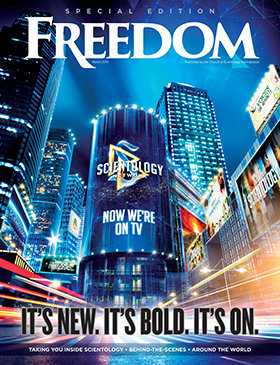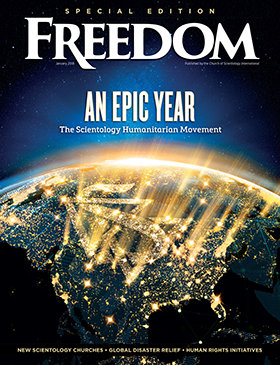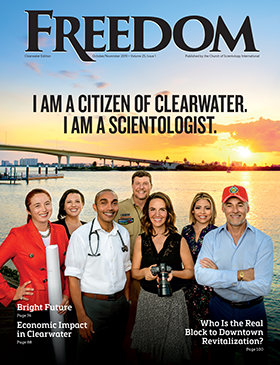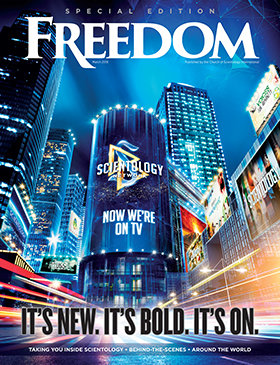The most prestigious contest of its kind on Earth fosters the imaginations that herald new realms of possibility and guide our civilization into tomorrow. Here is the 33rd annual celebration of L. Ron Hubbard’s desire to advance new artists.






As the sun set on another golden Friday in Hollywood, close to two dozen rookie science fiction and fantasy writers and artists from around the globe sat 75 feet above the noise and traffic on Hollywood Boulevard below.
So accustomed to creating new worlds, they were now instead taking in the surreal scene in front of them.
Down on the sidewalk, comic book heroes and fantasy characters in costume posed and interacted with tourists.
But here on the roof of Author Services, Inc. (ASI), home to the published fiction works of L. Ron Hubbard, these new writers and artists were sitting and dining with their heroes: the authors and illustrators of some of the 21st century’s greatest science fiction and fantasy.
The setting was the annual Writers and Illustrators of the Future, L. Ron Hubbard’s legendary contest that draws thousands of entries—short stories and illustrations—each year from around the world. Every three months, an illustrious panel of judges selects three quarterly winners in each category. The quarterly winners then convene in Hollywood for a weeklong series of workshops and events, culminating in the Awards Gala, where Grand Prize winners—recipients of the Golden Pen and Golden Brush Awards—are chosen.
Well into the 2017 week of events, on this Friday the first editions of the 33rd annual Writers of the Future anthology had been delivered to the writers and illustrators, containing their quarterly prize-winning stories and illustrations. Each gazed at their own words and artwork in published form for the first time, then signed 300 of the books in an autographing session.
Now they were sharing burgers and barbecue with some of the absolute biggest names in the industry—names who serve as their coaches and mentors, thanks to the contest.
The annual weekly workshop, culminating this year on April 2 in a Dragons and Dreamers-themed Gala Awards event at the Wilshire Ebell Theatre, marks the most prestigious contest in the genre. Writers of the Future past winners have published 1,150 novels and 4,450 short stories, as well as 32 New York Times best sellers—including some by one of this week’s coaches, Dave Wolverton, aka David Farland.
Past winners have also garnered 117 major awards, including a National Endowment for the Arts award, National Book Award, American Library Association Award, Edgar Award, World Fantasy Award, Pen/Faulkner Awards, and so many other international honors.
Seventeen Illustrators of the Future contest winners have won 144 awards, including an Academy Award (Shaun Tan for Best Animated Short Film 2011, The Lost Thing) and an Emmy Award nomination (David Hartman for Roughnecks: Starship Troopers Chronicles).
Yet such an elite and esteemed contest, which by now sees entries from 186 different countries, has very local roots.
In 1940, L. Ron Hubbard, already a well-known prolific writer and accomplished mariner, was land-bound while at port in Ketchikan, Alaska for a short period during his Alaskan coastal expedition under The Explorers Club flag. He passed some of his time appearing on a regular local radio program called The Golden Pen. During one episode, he invited locals to submit a short story for the Golden Pen Award, and said the contest was open to “anyone but professional writers.”
What started as a device to help encourage new writers, while stuck in a small Alaska town, became the international Writers of the Future competition in 1983, shortly after the publication of Mr. Hubbard’s internationally acclaimed and best-selling science fiction novel, Battlefield Earth. The Illustrators of the Future contest was added in 1988.
The high point of the annual contest is the Gala Awards dinner—held this year on Sunday evening, with more than 1,000 in attendance and thousands more watching via live streaming. The event this year called for black tie optional or medieval formal, and there were more than a handful who chose the latter. The stage was exquisitely decorated with an enormous fire-breathing dragon with a robotic eye that followed some on stage.
Early on, a video reminder of the importance of this ongoing contest was offered by the late Frank Kelly Freas, known as the “Dean of Science Fiction Arts,” and a former colleague of L. Ron Hubbard’s. Speaking of Mr. Hubbard, Freas said: “I think it is incredible that one person could have so much influence on other people’s lives. It’s hard to imagine anyone else doing this. This is the kind of thing that happens once in a century, if not once ever!”
The Gala included speeches by all of the quarterly winners, outstanding dance performances by EMCirque, presentation of the L. Ron Hubbard Lifetime Achievement Award to longtime judge and multiple Hugo Award winner Mike Resnick, speeches by many of the judges, and the presentation of the Golden Brush and Golden Pen Awards.
And while the quarterly awards, as well as the $5,000 Grand Prizes, certainly bring a significant amount of prestige and open a lot of doors for the writers and illustrators, it is the workshops from the award-winning judges and industry giants that make this week so impactful and unheard of.
How unique is this opportunity for writers and artists to be mentored in a casual environment? Imagine Beyoncé teaching a dozen kids how to sing, staying in the same hotel with them, and then telling showbiz stories at night. Or Michael Jordan having meals with a freshman basketball team, and teaching them how to shoot jump shots. For a week. And telling them they can call him anytime to discuss game strategy.
And doing all that for free.

Yes, that’s another amazing thing about this contest. Writers and illustrators from around the globe can enter the quarterly contests, as often as they like, at no cost. The quarterly finalists who are invited to the weeklong event in Los Angeles are then flown from their homes—wherever they are—and accommodated in a high-end Hollywood hotel, dined and even outfitted in formal wear for the Gala event, all at no expense.
The writers arrive on Monday, meet Contest Director Joni Labaqui and writers workshop instructors Tim Powers and David Farland, and hit the ground running Tuesday morning. Workshops continue all day—writers learning both about the craft and the business of science fiction and fantasy writing, as Powers and Farland fill their heads with knowledge, stories and assignments.
Illustrators arrive Tuesday, with a similar schedule the next day, learning tools and business tips from workshop instructors Echo and Lazarus Chernik and Val Lakey Lindahn. Concurrently, writers hit the streets, each executing their research assignments for a brand new story they will have just 24 hours to write and turn in.
The illustrators attend more workshops on Thursday on craft and business, while the writers furiously pound away before their 4 p.m. deadline. By 5 p.m., there’s time for fun, amazement and tears for both groups, at one of the week’s highlights: The Big Reveal.
Weeks before arrival, each of the quarterly illustrator winners was assigned a story written by one of the quarterly writer winners. Each was assigned the task of creating a drawing or painting—essentially the book cover for that short story—without ever discussing it with the writer. In fact, they’d never spoken to the writers, or even interacted with them—up to this point.
In a plush fourth-floor room of the ASI building, surrounded by books and illustrations from L. Ron Hubbard’s pulp fiction days as well as classic sci-fi and fantasy tomes, easels are set up in a U-shape, displaying the beautiful 2x3 foot paintings from the illustrators. Contest judges and staff admire the work, as the illustrators revel in each other’s creations.
Soon the group of illustrators quietly withdraws to the side. There is tension in the air as the artists await the reaction of their most important client to date: the authors of the stories their drawings will complement in the published anthology.
On the other side of an accordion-style door, there’s nervous laughter as the authors wait to be allowed in to see for the first time the art that will evoke their words. When the door is opened, the writers hesitantly enter in a somewhat organized single-file procession along the left side of the display, then across the back—until someone sees their drawing and breaks free.
“I see mine!” screams Jake Marley, a hefty, bearded man. “Oooh—oooh … it’s so nice!” he says, admiring Ryan Richmond’s haunting purple and red depiction of Marley’s ghost story, Acquisition. “That’s so cool,” he says while laughing. “Oh, you’re gonna get a hug for that,” Marley says to Richmond, a fourth-generation artist from Indiana. This is the first time he has met Marley, who would win the Golden Pen Award at Sunday’s Gala. The drawing is nothing like what Marley expected, he said, “But that’s part of the fun.”
This scene of delight and appreciation is repeated around the room, as writers meet the illustrators who have taken their words as a foundation for their art, and illustrators meet the authors who inspired them to create their newly published paintings.
Polish artist Michael Michera was very pleased to illustrate author C.L. Kagmi’s The Drake Equation “because it matches my interest,” he said, and because it has an important message. The drawing of a stunningly beautiful redhead in a meteor-destroyed spaceship is striking, and it’s what allowed Michera to fulfill a lifelong dream to come to America, and specifically Los Angeles.
He would go on, on Sunday night, to win the Golden Brush Award, stating, “This is the best day of my life. I’m glad we are in this world together,” then adding, “if this is my American Dream, I don’t want to wake up.”
But now, as Kagmi and Michera meet for the first time, they stand close, talking animatedly, each wearing a black shirt and pants, connected only by the story they now share. It is what all the artists and writers have in common—a vision of another world, another reality.
Yader Fonseca of Miami said he drew nearly 50 sketches before he really captured the world he was attempting to draw, a windy snowstorm on another planet to accompany Utah native Dustin Steinacker’s Envoy in the Ice. The storm depiction surprised the author. “I was not prepared at all. It really blew me away,” he said. “I’m really honored.”

Author David VonAllmen said of Chan ha Kim’s colorful and enchanting depiction of his The Magnificent Bhajan, “She captures so much detail! You don’t know if the words describing the story can do it justice, but her art did.”
Kim, barely 20 and a freshman at the University of Southern California, is incredibly gifted, and obviously shy. Already slight of stature, she is almost crouching in humility, wringing her hands, clearly uncomfortable in the adulation her work brings. Kim was also chosen to illustrate The Woodcutters’ Deity, a dark tale of evil spirits by Nigerian author Walter Dinjos, who was not able to attend.
At this moment, as her peers, other authors and the judges and media gush over her two strikingly different drawings, it appears USC’s Kim would like to be one of those who was not able to attend. In fact, close to tears, she will soon slip into a hallway to collect herself. Before she goes, though, VonAllmen tells her, “Your art is beautiful. You’re going to have to get used to being famous.”
Ziporah Hildebrandt is unable to thank her artist, Alpay, in person but sent him a video appreciation. “The way he captured the emotions and layers and metaphors—it’s amazing,” she said of the vibrant and bold red, gray and purple painting depicting both the strength and anguish of her main character. “I spent 15 years writing this, I dreamed it. And then I had to retro-engineer and translate and invent all of it. I had a kernel, and I had to stretch it out.”
On the other end of the spectrum, Molly Elizabeth Atkins, a mother of two young girls, finished her published finalist story Obsidian Spire in about a month, she said. And when she saw Aituar Manas’ drawing that accompanies her story, “I was overcome,” she said. “I imagined it would be exciting, but I didn’t know my artist would be able to capture it with such perfection.”
Manas, a 28-year-old artist from Kazakhstan, taught himself to draw by studying from images and lessons he found on the internet.
“All the artists have done an unreal job capturing these stories,” Atkins added.
There are more workshops ahead, along with tux and gown fittings to prepare for the Gala Awards event on Sunday. On Friday, authors hear from Robert J. Sawyer, Nancy Kress and L. Ron Hubbard Lifetime Achievement Award winner Mike Resnick. The illustrators hear from four judges: Val Lakey Lindahn, legendary Ukranian painter Sergey Poyarkov, and two judges new to the Illustrators of the Future workshops, Spain’s Ciruelo, renowned for his dragon paintings, as well as his unique work of detailed paintings on rocks, and Los Angeles’ Rob Prior, a rock star of a painter who often works in front of crowds before concerts, painting two-handed to high-decibel music.

Each is an admirer of the other, though they’ve never met before. Their back-to-back workshops are an example of the variations and range of styles and inspiration in the field. And the message each gave on discipline and creativity applies to writers as well.
Ciruelo, soft-spoken with sleek black hair pulled tight in a ponytail, spoke of getting started in the business by creating a book cover for George Lucas, but admitted his start as an artist was much earlier. “Since I was very little, I knew that art was going to be my life,” he said. Granted, most children like art, but the difference, he said, is that at 10 or 15 years old, someone tells you to get a real job. “[But] I never stopped being an artist.
“When I was 20, I was playing guitar, I had bands, I thought I might do that for a living,” he continued. “I started working with an advertising agency in Buenos Aires, and soon I realized I would be an artist.”
He became famous for his fantasy work, painting vividly-colored dragons, winning awards, book covers and more. While explaining his process, Ciruelo dropped a bit of a shock bomb on his listeners: “I’ve always had trouble with colors,” he said. “Actually, I’m color-blind. It gave me an extra sensitivity and perception for light, shapes and shades.”
Later in his career, he felt a calling to go to a hill near his house and pick up rocks, about a foot or more in size, and they spoke to him. “I would see a dragon, then a bird, then a woman, then a horse. I would wait until one image was clear,” he explained, “and the others would go away.” He would wash them, but never cut them, and paint intricate detailed stories on the surface using oil.
“I knew very early on that I didn’t come here to work. I just want to have fun. And that’s what I’m doing. And I’m making my living. I wake up every day and I’m excited to do my work every day. For me, 24 hours is not enough.”
Rob Prior, with short, graying hair and a rock ’n’ roll attitude, has a polar opposite approach. “I don’t like any of the work I’ve done,” he told the group. “But that’s just me. You always have to strive to do better.
“I do four things at once—I paint, I write, I tell stories, I direct. This way if I’m stuck I always have an avenue to turn down. That’s how I get around artist’s block,” Prior said, adding, “or I go for a walk, or drink a beer, or some tea—anything to get out of my head. Or,” he added, “just draw.”
He has always painted with two hands, and paints rapidly and frenetically. Then last year, while lifting weights, he blew out a tendon in his left arm and needed surgery. “I don’t know how any of you people paint with just one hand!” he mockingly screamed at them. Then, he had them do an exercise.
The artists each picked up a pen with their opposite hand. He told them to close their eyes and then to draw a human eye. “Do it!” he exhorted. Most, if not all created a better than average sketch, more accomplished than most people could do with their dominant hand and their eyes open.
But a few struggled. “You know why? You were drawing from your mind. You were using your head, you weren’t feeling it. Art is from here,” he said, pounding on his chest, “from your heart. When you touch paper from now on, touch it with your heart.
“The brain is what stops everyone,” he continued. “Your brain would say, ‘be a lawyer, be a doctor.’ Your brain would freak out when you get a rejection letter, and that ball of fear grows. Forget that. You are the ones who make your path. So do it.”
Later, Ciruelo spoke of his transition to painting on rocks as being related to primal art. “It’s like a spiral, a straight line does not exist for me. It’s more like an ancient knowledge.
“The consciousness is the most advanced technology we have in the galaxy. We’re just remembering what we’ve already done in the past.”

















































